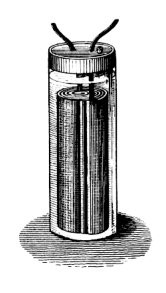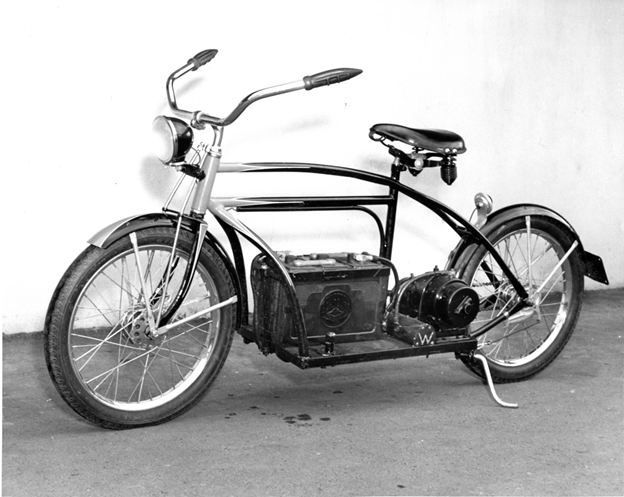
A History of Electric Scooters
Image Credit: Mariordo (Mario Roberto Durán Ortiz) [CC BY-SA 4.0]
Writer: John Linden
If you have been around any larger cities recently, odds are you have seen tons of those rideshare electric scooters around. The eco-friendly nature and convenience of electric scooters have seen an explosion in their popularity in recent years. With the fast proliferation of these electric scooters, one may think that electric scooters are a relatively recent phenomenon. Interestingly enough, did you know that the first patent of an electric motorbike actually dates back to 1895, a full year before the invention of the first gas-powered motorbike? Let’s take a deep dive into the history of the electric scooter to see where it all started.
1700s
The history of electric-powered transportation devices began back in 1740 when experimenters like Benjamin Franklin and Andrew Gordon created the very first electric motors. These first motors were very simple and could only be powered by an external power source. In 1799, Italian physicist Alessandro Volta (the guy that the “volt” is named after) invented the practical batteries that could provide a constant source of power for electric motors. These initial batteries were also rather weak and could not provide much power, but they set the stage for advancements in battery and electric motor tech.
1800s
In 1859, French physicist Gaston Planté invented the first lead-acid batteries, the kind of batteries we now use in cars. These batteries were much more efficient and could provide enough power to use for human transportation. The early 1800s saw the invention of several electric devices for human transportation, such as the electric tricycle invented by Gustave Trouvé in 1881 and the famous “electric carriage” built by William Aryton & John Perry a year later. These early battery-powered devices could reach speeds up to 25 mph.

We do not actually know when the very first electric bike was ever invented, but the first recorded patent for an electric bicycle was filed by American inventor Ogden Bolton Jr. back in 1895. The text of the patent states that Ogden’s model was supposed to be an improvement in electric bicycles, which indicates electric bikes existed previously.
Various electric bikes and mopeds were invented in the next 20 years, including Humber’s famous electric tandem bicycle and the invention of smaller nickel-cadmium batteries in 1899. At the time, gas-powered engines were still very inefficient so electric scooters, bikes, and mopeds were seriously considered for daily transportation.
1900s-1940s
In 1911, the magazine Popular Mechanics showcased an ebike that could reach a max speed of 35 mph—a full 40% faster than the best gas-powered scooters available at the same time. This ebike could reach distances of up to 100 miles on a single battery charge. In 1911, British agricultural company Ransomes, Sims, and Jeffries released the first electric motorcycle with a sidecar that carried the batteries.
Developments in electric scooters stalled for the next 20 or so years after a Long-Island based company released the Autoped, a competent gas-fueled scooter that saw many sales in the US and Germany. The development of new more efficient gas-powered engines saw many companies manufacture gas-powered scooters. Unfortunately, these gas-powered scooters were often seen as low class and it took a few decades for people to change their minds on the product.
Developments in electric ebikes saw a small spike during the years of WWII, spurned on by petrol shortages in Germany and the US. A handful of these companies, such as ParCar, are still making electric bikes to this day.
Image Credit: William ""Bill"" Wheatley Collection Photo Electric bicycle

1940s-1980s
During the 1940s, many companies hopped on the wagon of making gas-powered scooters. These scooters were a rather big success and some models were even adopted by the US military. Although these products sold relatively well, they weren’t by any means popular consumer goods and most common people didn’t bother buying one.
The rise of environmentalism in the 1960s saw new developments in ebikes. In 1967, Austria chemist Karl Kordesch made the first gas/electric hybrid motorcycle and in 1975, American inventor Mike Corbin invented the City Bike, a street-legal electric bike that could reach speeds up to 30 mph. In fact, a year earlier, Mke Corbin set the electric motorcycle land speed record with his custom-built QuickSilver that could reach a top speed of 165 mph. This record was not beaten until 2012.
Also in 1975, California manufacturer Auranthic Corp. released the Charger another street-legal bike that was extremely popular in California.
1980’s-Present
The past few decades have seen even more advancements in electric scooter technology. The first mass-produced electric scooter called the Scoot’Elec was invented in 1996 by Peugeot and had a top speed of 31 mph and a range of 29 miles. The Scoot’Elec was very successful even though it was heavy and not very eco-friendly due to its nickel-cadmium batteries.
The early 1990s also saw the invention of the lithium-ion battery, the kind of batteries that power most laptops, smart phones, and tablets nowadays. Lithium-ion batteries were much more efficient than nickel-cadmium batteries and much more eco-friendly.
The modern wave of electric scooter began in 2009 when Myway turned into Inokim and became one of the leading electric scooter manufacturers. These scooters made full use of new more efficient lithium-ion batteries to make fast scooters that could be charged at home.
Nowadays, there are dozens of electric scooter manufacturers in several countries and they are becoming a common sight in most cities. Several rideshare companies like Uber and Lime have electric scooters you can rent for one-off trips. People favor electric scooters due to their portability, ease of use, low environmental footprint, less maintenance, and fewer regulations compared to more traditional methods of transportation. The fuel cost of a gas-powered scooter is almost 4 times as high as an electric scooter and gas-powered scooters actually emit more greenhouse gasses than cars proportional to their size. The current fastest electric scooter on the market is the NANROBOT LS7 which can reach a top speed of 52 mph, almost highway speeds.
So you can see why people are so excited about electric scooters and why this trend is probably here to stay.
Updated